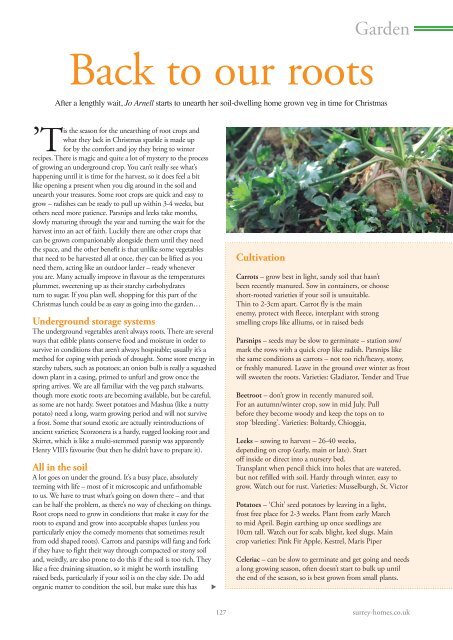Surrey Homes | SH38 | December 2017 | Health & Beauty supplement inside
The lifestyle magazine for Surrey - Inspirational Interiors, Fabulous Fashion, Delicious Dishes
The lifestyle magazine for Surrey - Inspirational Interiors, Fabulous Fashion, Delicious Dishes
Create successful ePaper yourself
Turn your PDF publications into a flip-book with our unique Google optimized e-Paper software.
Back to our roots<br />
Garden<br />
After a lengthly wait, Jo Arnell starts to unearth her soil-dwelling home grown veg in time for Christmas<br />
the season for the unearthing of root crops and<br />
what they lack in Christmas sparkle is made up<br />
’Tis<br />
for by the comfort and joy they bring to winter<br />
recipes. There is magic and quite a lot of mystery to the process<br />
of growing an underground crop. You can’t really see what’s<br />
happening until it is time for the harvest, so it does feel a bit<br />
like opening a present when you dig around in the soil and<br />
unearth your treasures. Some root crops are quick and easy to<br />
grow – radishes can be ready to pull up within 3-4 weeks, but<br />
others need more patience. Parsnips and leeks take months,<br />
slowly maturing through the year and turning the wait for the<br />
harvest into an act of faith. Luckily there are other crops that<br />
can be grown companionably alongside them until they need<br />
the space, and the other benefit is that unlike some vegetables<br />
that need to be harvested all at once, they can be lifted as you<br />
need them, acting like an outdoor larder – ready whenever<br />
you are. Many actually improve in flavour as the temperatures<br />
plummet, sweetening up as their starchy carbohydrates<br />
turn to sugar. If you plan well, shopping for this part of the<br />
Christmas lunch could be as easy as going into the garden…<br />
Underground storage systems<br />
The underground vegetables aren’t always roots. There are several<br />
ways that edible plants conserve food and moisture in order to<br />
survive in conditions that aren’t always hospitable; usually it’s a<br />
method for coping with periods of drought. Some store energy in<br />
starchy tubers, such as potatoes; an onion bulb is really a squashed<br />
down plant in a casing, primed to unfurl and grow once the<br />
spring arrives. We are all familiar with the veg patch stalwarts,<br />
though more exotic roots are becoming available, but be careful,<br />
as some are not hardy. Sweet potatoes and Mashua (like a nutty<br />
potato) need a long, warm growing period and will not survive<br />
a frost. Some that sound exotic are actually reintroductions of<br />
ancient varieties; Scorzonera is a hardy, rugged looking root and<br />
Skirret, which is like a multi-stemmed parsnip was apparently<br />
Henry VIII’s favourite (but then he didn’t have to prepare it).<br />
All in the soil<br />
A lot goes on under the ground. It’s a busy place, absolutely<br />
teeming with life – most of it microscopic and unfathomable<br />
to us. We have to trust what’s going on down there – and that<br />
can be half the problem, as there’s no way of checking on things.<br />
Root crops need to grow in conditions that make it easy for the<br />
roots to expand and grow into acceptable shapes (unless you<br />
particularly enjoy the comedy moments that sometimes result<br />
from odd shaped roots). Carrots and parsnips will fang and fork<br />
if they have to fight their way through compacted or stony soil<br />
and, weirdly, are also prone to do this if the soil is too rich. They<br />
like a free draining situation, so it might be worth installing<br />
raised beds, particularly if your soil is on the clay side. Do add<br />
organic matter to condition the soil, but make sure this has<br />
<br />
Cultivation<br />
Carrots – grow best in light, sandy soil that hasn’t<br />
been recently manured. Sow in containers, or choose<br />
short-rooted varieties if your soil is unsuitable.<br />
Thin to 2-3cm apart. Carrot fly is the main<br />
enemy, protect with fleece, interplant with strong<br />
smelling crops like alliums, or in raised beds<br />
Parsnips – seeds may be slow to germinate – station sow/<br />
mark the rows with a quick crop like radish. Parsnips like<br />
the same conditions as carrots – not too rich/heavy, stony,<br />
or freshly manured. Leave in the ground over winter as frost<br />
will sweeten the roots. Varieties: Gladiator, Tender and True<br />
Beetroot – don’t grow in recently manured soil.<br />
For an autumn/winter crop, sow in mid July. Pull<br />
before they become woody and keep the tops on to<br />
stop ‘bleeding’. Varieties: Boltardy, Chioggia,<br />
Leeks – sowing to harvest – 26-40 weeks,<br />
depending on crop (early, main or late). Start<br />
off <strong>inside</strong> or direct into a nursery bed.<br />
Transplant when pencil thick into holes that are watered,<br />
but not refilled with soil. Hardy through winter, easy to<br />
grow. Watch out for rust. Varieties: Musselburgh, St. Victor<br />
Potatoes – ‘Chit’ seed potatoes by leaving in a light,<br />
frost free place for 2-3 weeks. Plant from early March<br />
to mid April. Begin earthing up once seedlings are<br />
10cm tall. Watch out for scab, blight, keel slugs. Main<br />
crop varieties: Pink Fir Apple, Kestrel, Maris Piper<br />
Celeriac – can be slow to germinate and get going and needs<br />
a long growing season, often doesn’t start to bulk up until<br />
the end of the season, so is best grown from small plants.<br />
127 surrey-homes.co.uk


















